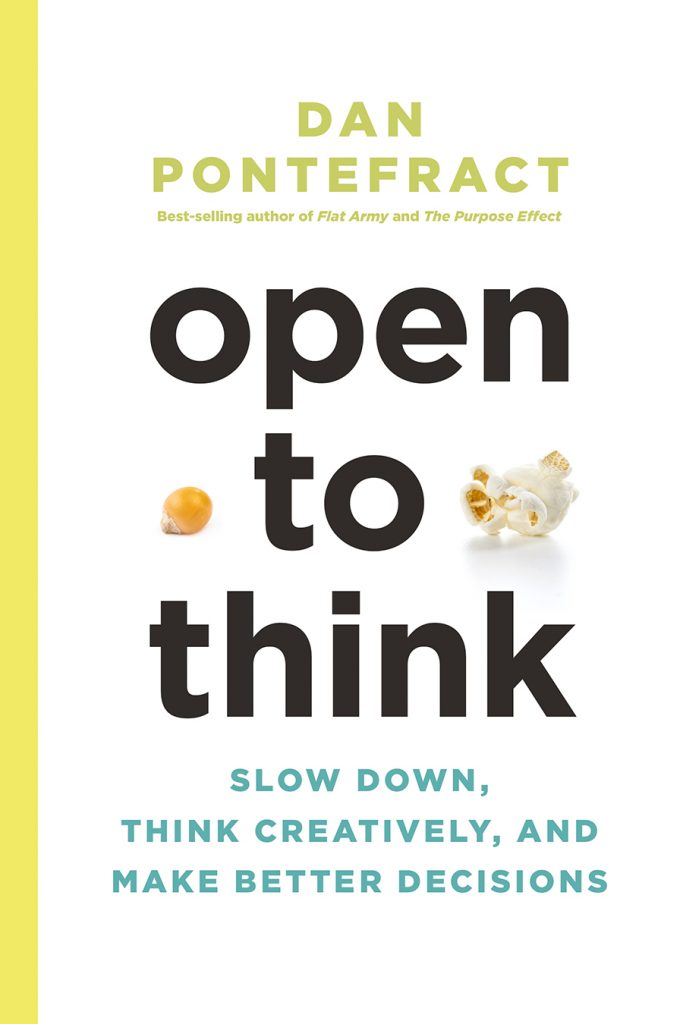The Newsroom
Excerpt: “Open To Think” – When One Thinks
Available September 2018, Open to Think is an appeal for a world of better thinking where best-selling author and Chief Envisioner, Dan Pontefract, introduces tangible, actionable strategies to improve the way we think as organizations and individuals. Here’s an exclusive edited version of the first chapter.
When One Thinks
When we think we are using our mind to actively form or connect an idea. But there is more to the word think. Thinking is also an approach, a possibility, a deliberation, an opinion, or an attitude. It can even be a belief or a conclusion.
Let’s first contemplate the act of thinking.
Thinking can happen in parallel. That is, you can think about one thing while doing something completely different. When you take a shower, for example, you go through a routine that you have likely performed thousands of times. Your brain thinks through the routine and action ensues. Soak. Soap. Lather. Rinse. Repeat. It’s been like that for years, so why change?
But maybe while lathering or rinsing you have a chance to simultaneously unleash thinking that may be more creative or critical than simply lathering soap over your body. I shave my head and face every morning in the shower. It has been a routine of mine for more than 20 years. But during the shave I often float into a state of endless possibility and wonderment. The medical community calls it automaticity, when a cell spontaneously generates action without an external stimulus. My morning ritual has become a daily five-minute instance of ideation and decision-making while I continue completing the task of shaving without cutting myself. I am getting things done in more ways than one.
Thinking—like eating—is something we all do. In fact, we are all constantly thinking. But as with eating, there are both healthy and unhealthy habits we must become more aware of.
Thinking is both conscious and unconscious. It is voluntary and involuntary. It is equal parts contemplative, interrogative, and active. It is automatic and manual. We can control thought, but there are times when our thinking becomes instinctive. It is the quality and healthiness of thinking, however, that we must reconsider. While a chocolate donut or greasy fries are fine in moderation, when unhealthy food choices become the norm, our physique suffers. We become obese, subjecting our bodies to more complicated maladies such as diabetes or heart disease. Similarly, if you constantly employ poor thinking habits, don’t be surprised if your life becomes detrimentally affected over time.
Thinking is multifaceted. The type of thinking we want to focus on in this book does not pertain to avoiding car crashes or saving a patient’s life. Open to Think is not a book about the psychology or neuroscience of thinking, nor is it intended to rehash Design or Integrative Thinking. Furthermore, it is also not aimed at those who actually enjoy repetition in their role at work. The kind of thinking we are going to analyze is more conscious than unconscious, more interrogative and contemplative than innate or automatic. It is the type of thinking that you have control of in your daily lives—including your role at work—and the kind you, hopefully, want to improve.
To do so, I urge you to consider doing something throughout the book. As you delve into Open to Think, I encourage you to continuously assess how you think. In doing so, you are not simply reading the book, you are potentially developing better thinking habits along the way. Try asking yourself these three simple questions as you journey through the pages:
- Do I spend enough time reflecting and dreaming?
- Do I make thorough decisions based on facts and evidence?
- Do I rush to complete an action?
